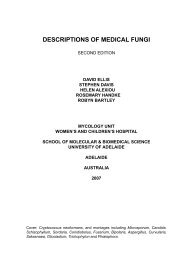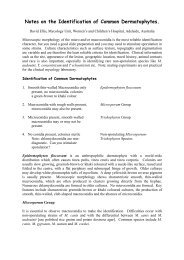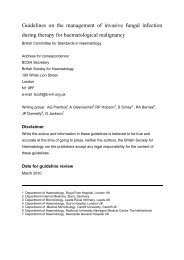1999 QAP Report - Mycology Online
1999 QAP Report - Mycology Online
1999 QAP Report - Mycology Online
You also want an ePaper? Increase the reach of your titles
YUMPU automatically turns print PDFs into web optimized ePapers that Google loves.
99:4:8A Onychocola canadensis 41 % correct to species level<br />
This was the first time this organism was sent out in the <strong>QAP</strong> so the results were<br />
quite good. The incorrect answers were spread evenly over a large number of<br />
yeasts and moulds. Onychocola canadensis is an arthroconidial fungus and a rare<br />
cause of nail and skin infections. Colonies are slow growing, white to yellowish<br />
with a suede-like surface and brownish reverse. Hyphae form long chains of<br />
arthroconidia which are cylindrical to broadly ellipsoidal, 1-2 celled, hyaline to<br />
subhyaline, 4-16 x 2-5 ìm in size. Older cultures form broad, brown, septate,<br />
sterile hyphae with darker brown knobs.<br />
99:4:8B Trichophyton tonsurans 85 % correct to species level<br />
Trichophyton tonsurans has been sent out several times in recent years and<br />
proficiency in identification has increased from ~40% to 85%. T. tonsurans is an<br />
anthropophilic fungus with a worldwide distribution, which causes inflammatory<br />
or chronic non-inflammatory finely scaling lesions of skin, nails and scalp. It is a<br />
common cause of tinea capitis in the Australian Aborigine. Invaded hairs show an<br />
endothrix infection and do not fluoresce under Wood's ultra-violet light.<br />
99:4:8C Trichophyton terrestre 67 % correct to species level<br />
Trichophyton terrestre is a geophilic fungus of worldwide distribution, which may<br />
occur as a saprophytic contaminant on humans and animals. It is not known to<br />
invade hair in vivo, but produces hair perforations in vitro.<br />
99:6:8A Scedosporium prolificans 57 % correct to species level<br />
86 % correct to genus level<br />
30% of respondents called this S. apiospermum. Scedosporium prolificans is<br />
distinguished from other members of the genus, in particular, S. apiospermum, by<br />
having basally swollen (inflated), flask-shaped annellides, slower colony<br />
development on nutrient agar media, and by not growing on media containing<br />
cycloheximide (actidione). Disseminated disease has been reported in<br />
immunosuppressed patients especially those with prolonged neutropenia and posttransplantation<br />
therapy. However, localized invasive infections, especially septic<br />
arthritis and osteomyelitis following penetrating injuries to joints, are now an<br />
emerging clinical problem, accounting for 80% of the reported cases. Culture<br />
identification is important, because this fungus is often resistant to antifungal<br />
therapy and treatment may require surgical intervention.<br />
99:6:8B Absidia corymbifera 57 % correct to species level<br />
73 % correct to genus level<br />
20 % misidentified as Mucor sp.<br />
The genus Absidia is characterized by a differentiation of the hyphae into arched<br />
stolons bearing more or less verticillate sporangiophores at the internode, and<br />
rhizoids formed at the point of contact with the substrate (at the node). This<br />
feature separates species of Absidia from the genus Rhizopus, where the sporangia<br />
arise from the nodes and are therefore found opposite the rhizoids. The sporangia<br />
are relatively small, globose, pyriform- or pear-shaped and are supported by a<br />
characteristic funnel-shaped apophysis. This distinguishes Absidia from the<br />
genera Mucor and Rhizomucor, which have large, globose sporangia without an<br />
apophysis. Absidia currently contains 21 mostly soil-borne species. A.<br />
corymbifera is the only species of Absidia known to cause disease in man and<br />
animals. It is also the only species of Absidia to grow at 40 O C. Absidia<br />
corymbifera is a common human pathogen, causing pulmonary, rhinocerebral,<br />
C:\Documents\Qap\<strong>QAP</strong>R99.doc



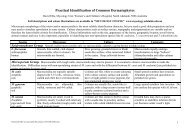

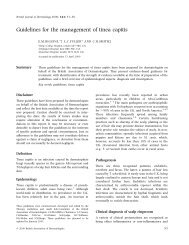
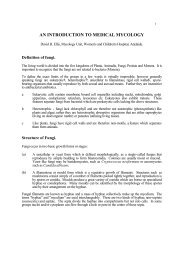

![List for QAP Fungi [2006].](https://img.yumpu.com/36263775/1/184x260/list-for-qap-fungi-2006.jpg?quality=85)
